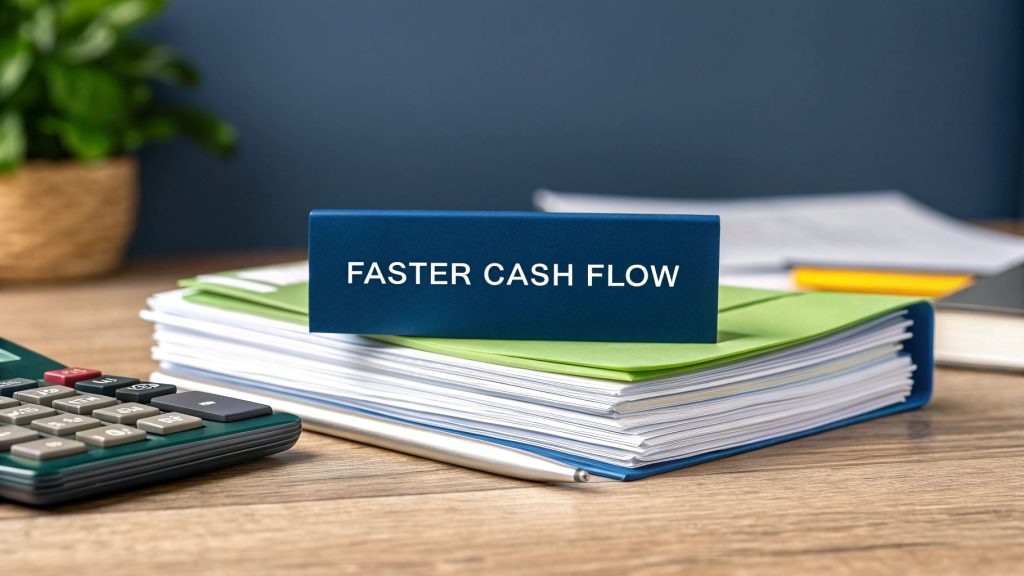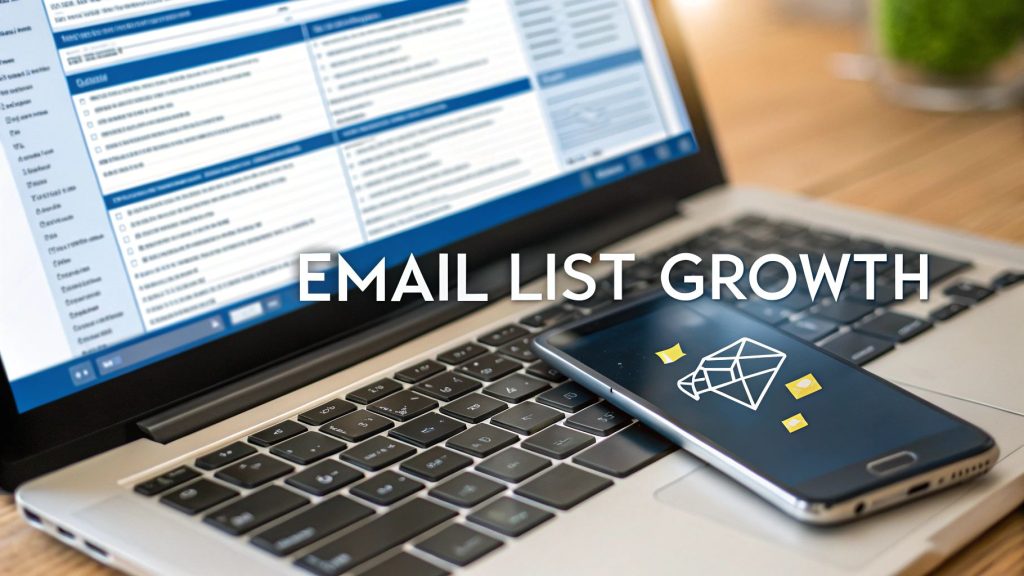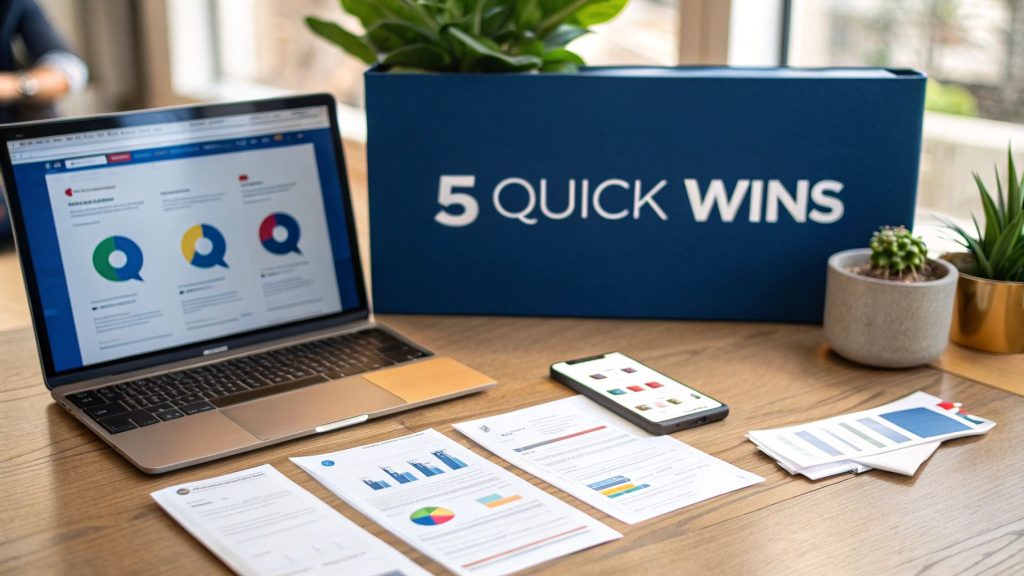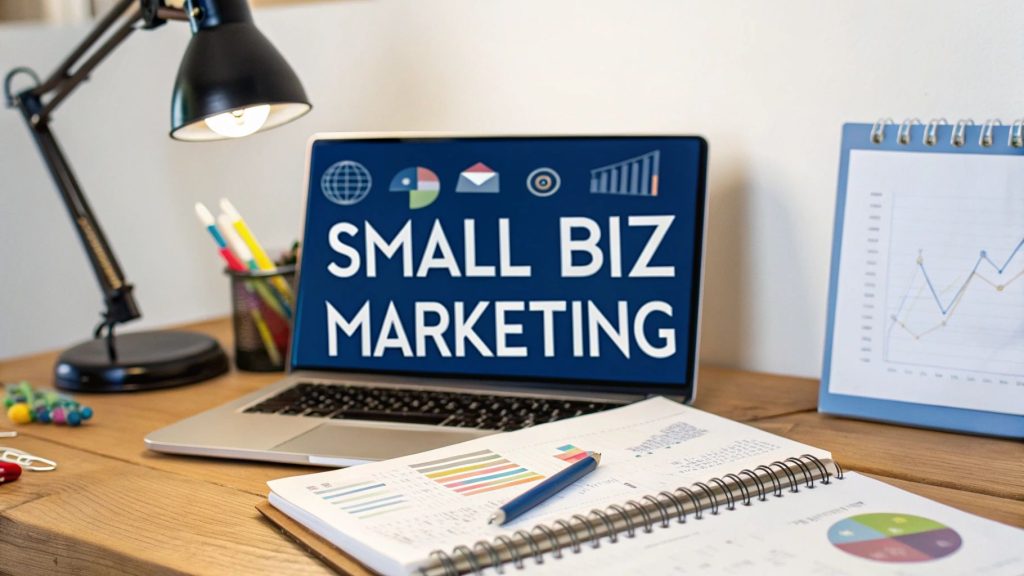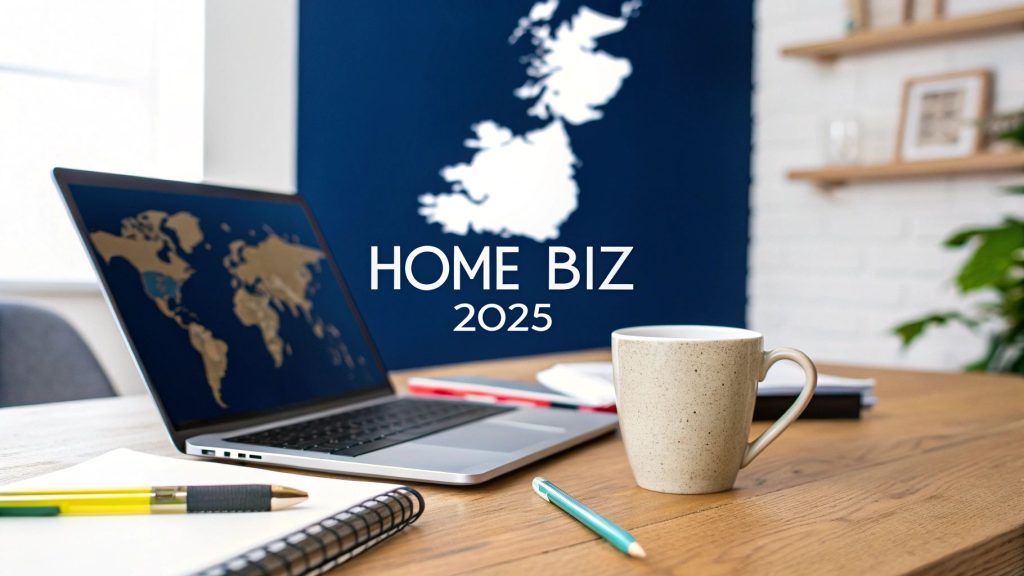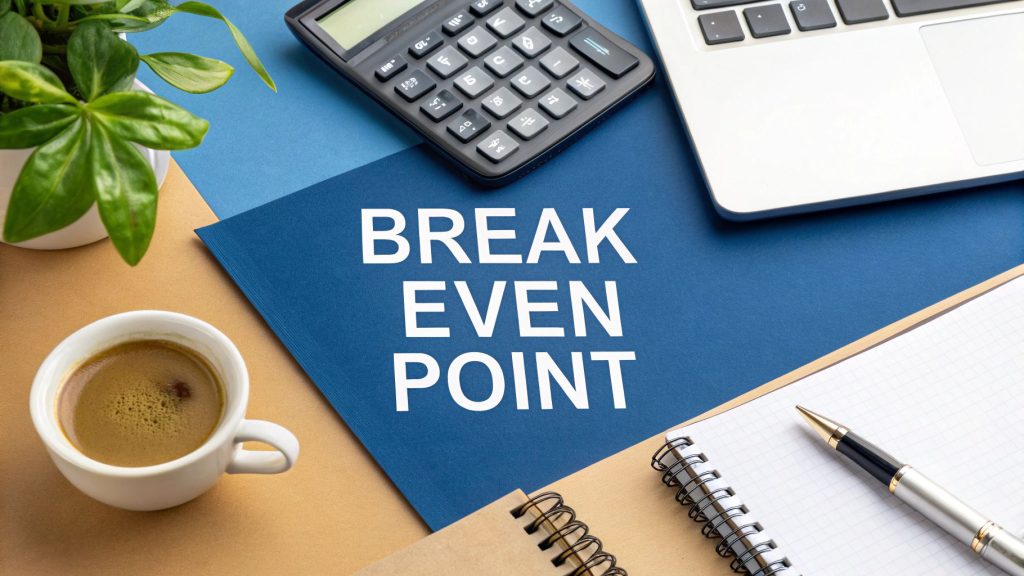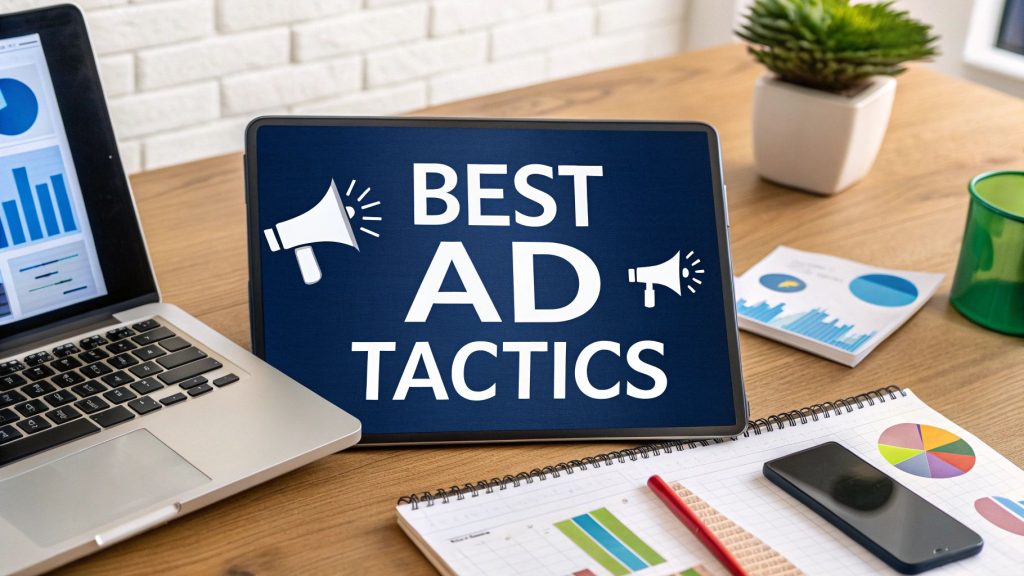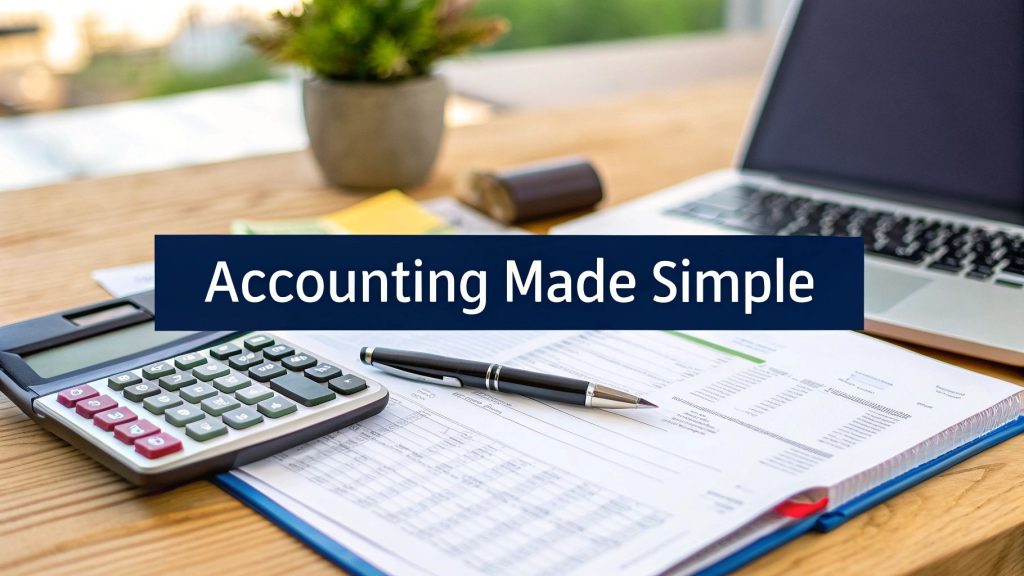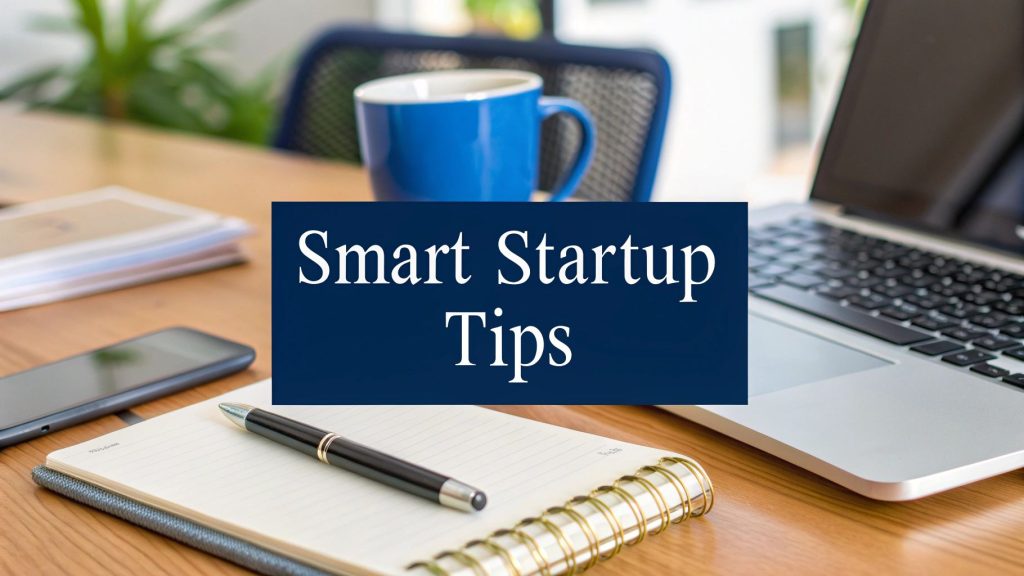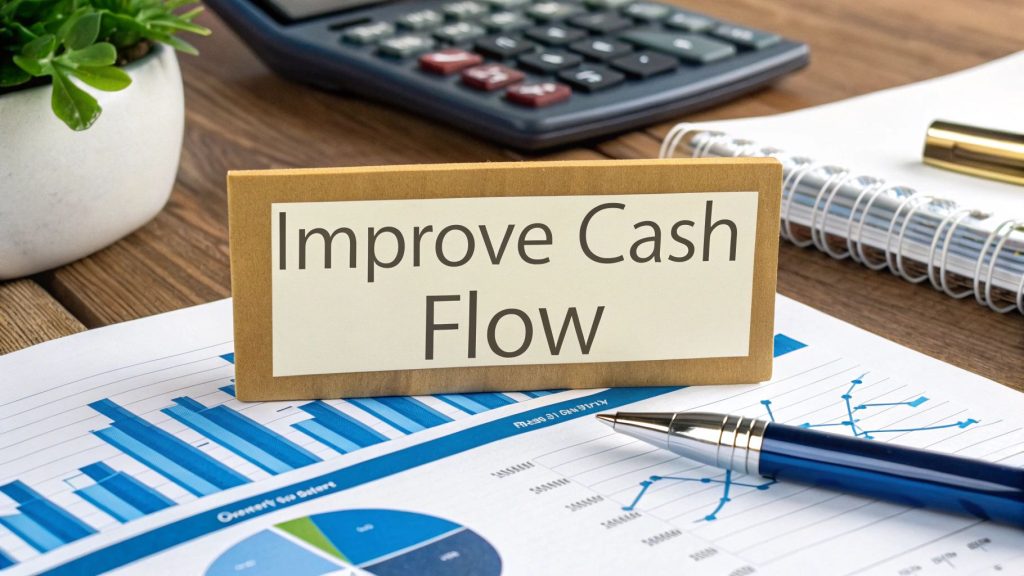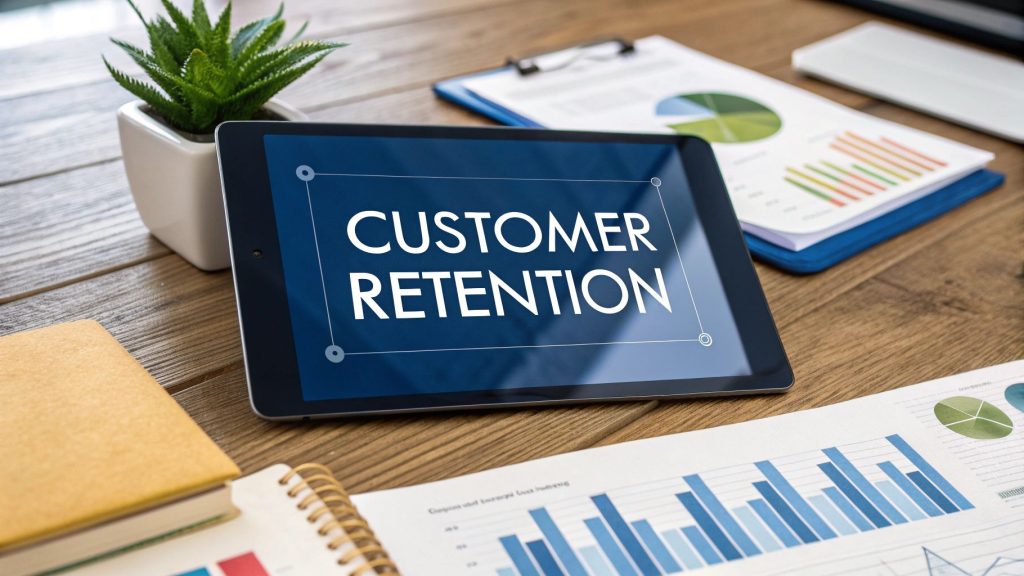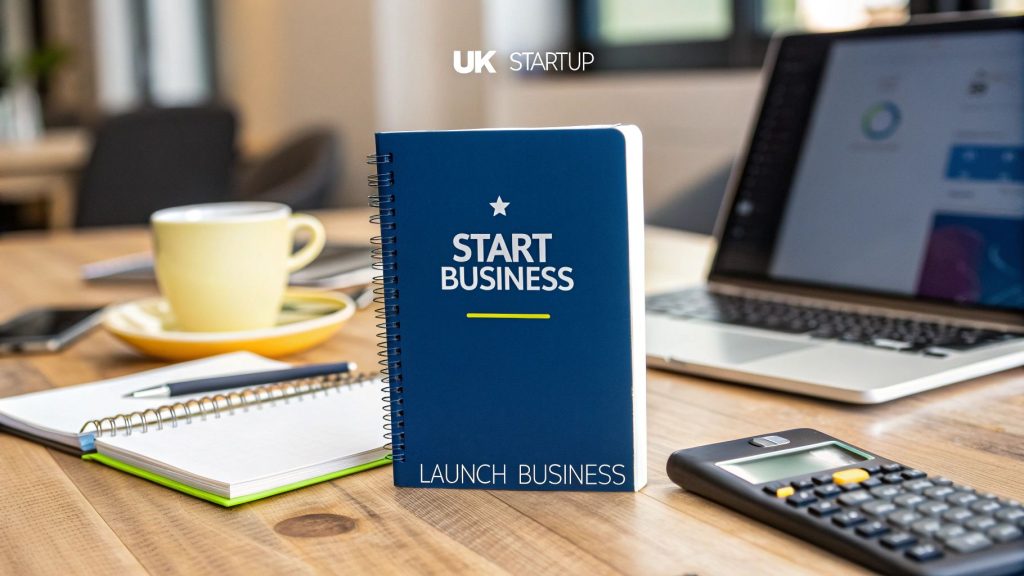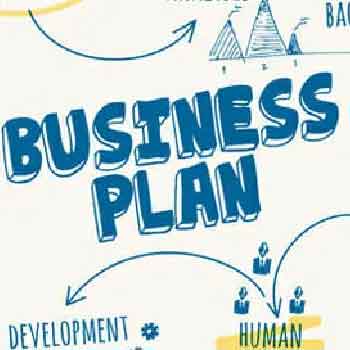What Is a Business Model Canvas?
If you’ve ever felt buried under a mountain of paperwork trying to explain your business idea, you’re not alone. The traditional business plan can be a dense, lengthy document that’s hard to update and even harder for others to digest quickly. But what if you could map out your entire business on a single page?
That’s exactly what the Business Model Canvas lets you do. Think of it less like a fifty-page report and more like an architect’s blueprint. It’s a visual chart that shows how all the crucial parts of your business—from customers to costs—fit together in one coherent picture.
Your Entire Business Strategy on a Single Page
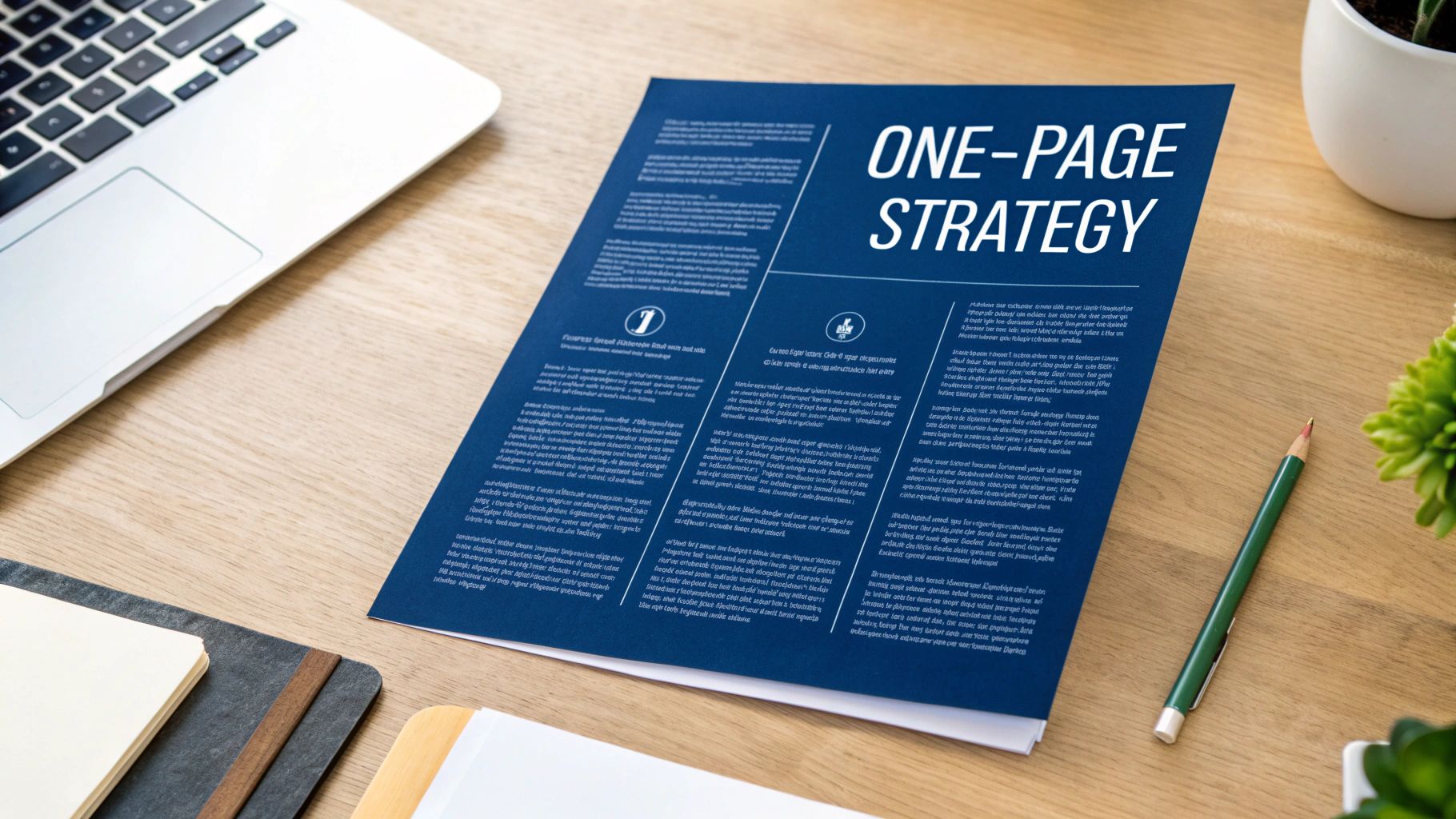
Imagine trying to get your team, your investors, or even yourself on the same page without wading through pages of text. The Business Model Canvas solves this by breaking down your strategy into nine essential building blocks. This powerful framework gives you a clear, high-level view of how your company actually creates, delivers, and makes money.
Developed by Alexander Osterwalder, it’s a dynamic tool that’s just as useful for a brand-new start-up as it is for an established company looking to innovate. It’s designed for quick discussions, smart pivots, and collaborative planning without getting bogged down in unnecessary detail. The visual layout makes complex ideas easy to grasp, turning a tangled concept into a clear, actionable strategy.
For instance, a tech start-up can use it to quickly identify its most profitable customer segments, while a high-street retailer could use it to brainstorm new delivery channels or partnerships.
The canvas acts as a shared language, ensuring everyone from marketing to operations is aligned on the same strategic vision and goals.
Its impact is hard to overstate. Since its introduction in 2004, it has become a cornerstone for entrepreneurs and business leaders across the UK. In fact, by the early 2020s, some reports suggested that as many as 9 out of 10 UK SMEs had used the framework to clarify and communicate their business strategy.
Instead of a static document that gathers dust, think of the canvas as a living tool that evolves with your business. While it gives you that crucial strategic snapshot, you’ll likely still need a more detailed document for lenders or investors. When you get to that stage, you can download our free business plan template to get started.
Deconstructing the Nine Core Building Blocks
The Business Model Canvas is split into nine essential building blocks, each one representing a core part of your business. The real magic isn’t in filling out each box in isolation; it’s about seeing them as interconnected gears that drive your company forward. Answering the key questions in each block helps you build a complete, coherent picture of your entire strategy.
Think of the canvas as being split right down the middle. The right side is all about your customers—who they are, what you offer them, and how you make money. The left side is the engine room—it covers the internal operations and costs needed to make it all happen.
Let’s break them down one by one.
The Customer-Facing Side
This is where you map out your relationship with the market. It’s all about defining who you’re serving and how you’ll turn that relationship into revenue.
- Customer Segments: Who are you actually creating value for? For a local coffee shop, this could be ‘morning commuters’ and ‘freelancers’. Getting laser-focused here is vital.
- Value Propositions: What problem are you solving? A fitness app’s value proposition might be ‘achieve your health goals with personalised 15-minute workouts you can do anywhere’.
- Channels: How do you actually reach your customers to deliver your value proposition? This could be a website, a physical shop, social media, or a dedicated sales team.
- Customer Relationships: What kind of relationship does each customer segment expect from you? For an online bank, this might be ‘automated self-service via the app’, while a bespoke tailor would offer ‘dedicated personal assistance’.
- Revenue Streams: How will you actually make money? This block defines your pricing strategy. For a SaaS company, this could be tiered monthly subscriptions. For a retailer, it’s direct product sales.
This infographic neatly shows the fundamental link between knowing your customers, offering them something they value, and generating revenue.
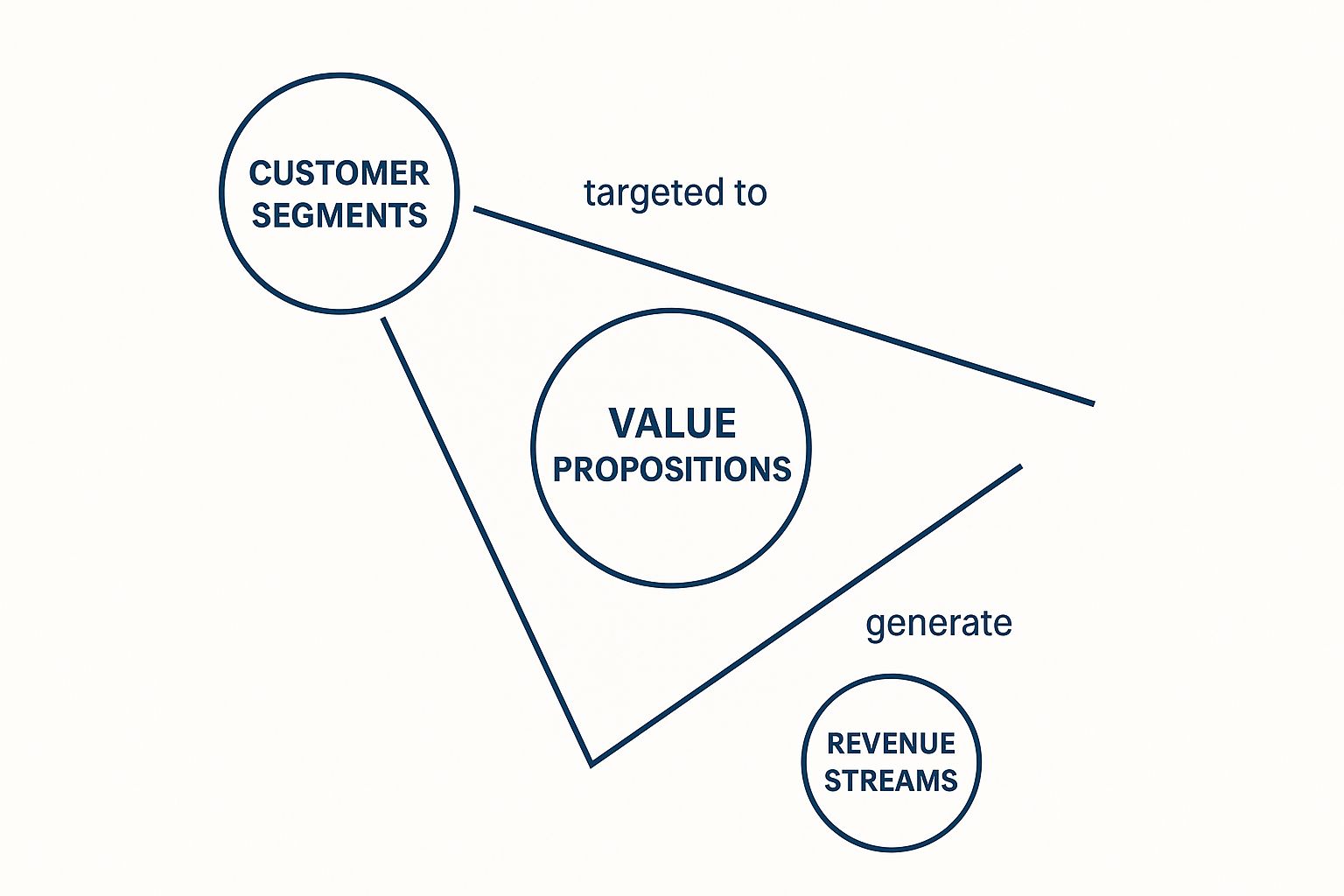
As you can see, without a clear customer segment, your value proposition has no target. And without a compelling value proposition, your revenue streams simply won’t materialise.
The Business-Facing Side
This half of the canvas details the operational mechanics of your business—everything required to make the customer-facing side work smoothly. It’s the nuts and bolts of your company.
- Key Activities: What are the most important things your company must do to operate successfully? For a software company, a key activity is ‘coding and bug-fixing’. For a delivery service, it’s ‘logistics management’.
- Key Resources: What essential assets do you need to deliver your value? These can be physical (like a delivery fleet), intellectual (a brand patent), human (expert developers), or financial.
- Key Partnerships: Who are the key suppliers and partners that make your business model tick? An independent bookshop might partner with local authors and coffee suppliers to enhance its offering.
- Cost Structure: What are the most significant costs you’ll incur while operating? For a restaurant, key costs include ‘staff wages’ and ‘ingredient supply’. For an e-commerce store, it’s ‘website hosting’ and ‘marketing spend’.
Thinking through these nine blocks forces you to connect every part of your business strategy into a single, powerful snapshot. While the canvas gives you a fantastic high-level view, you might also find it useful to dive deeper into your company’s internal strengths and weaknesses. For that, you can grab a free SWOT analysis template to complement your planning.
How Real Businesses Use the Canvas
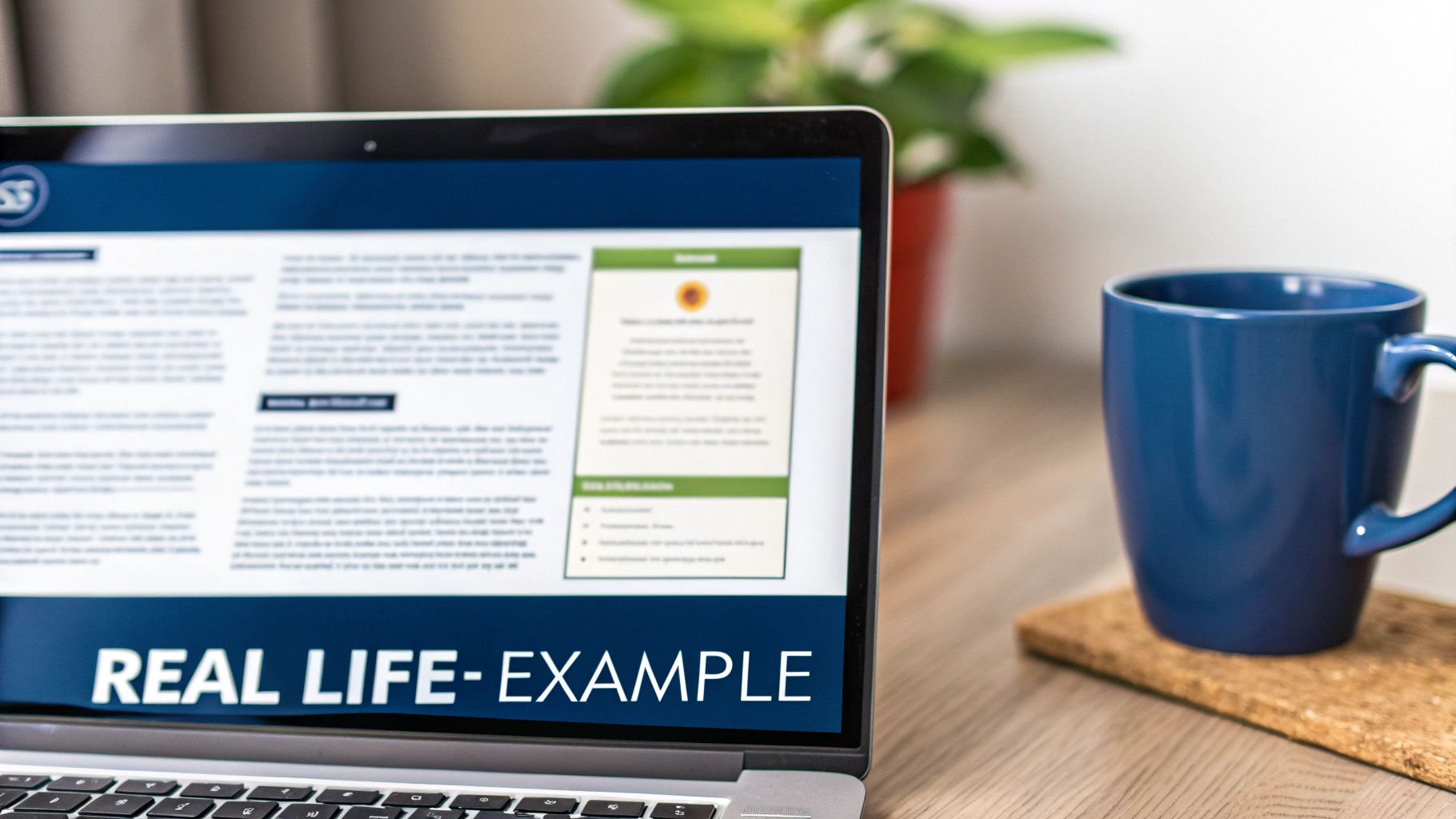
Theory is one thing, but the Business Model Canvas really comes alive when you see it in action. It’s a versatile tool that can map out anything from a global digital giant to a local UK start-up, telling the story of how a business actually works on a single page.
Let’s start with a household name: Spotify. Its canvas would show two distinct Customer Segments: free users who listen to adverts, and premium subscribers who pay to skip them. The Value Proposition for both is simple—instant access to a massive library of music and podcasts, anywhere, anytime.
Their Channels are pretty straightforward: the mobile and desktop apps. Spotify’s Customer Relationships are largely automated, driven by clever algorithms and personalised playlists that keep you hooked. This entire setup creates two core Revenue Streams: advertising income from the free listeners and subscription fees from premium members.
From Global Giants to Local Start-ups
Now, let’s bring it closer to home with a relatable UK start-up—say, a local, eco-friendly meal kit delivery service based in Manchester. This shows how the canvas works for a new venture right from day one.
- Customer Segments: The target market is environmentally conscious professionals and busy families in Greater Manchester. These are people who want the convenience of a meal kit but also value fresh, local ingredients.
- Value Proposition: The offer is pre-portioned, farm-to-table meal kits with zero-plastic packaging. It saves customers time on shopping and meal planning while supporting local suppliers—a win-win.
- Channels: Their main channels would be a user-friendly website for subscriptions, a stall at local farmers’ markets for promotion, and targeted social media campaigns on Instagram and Facebook.
For this company, its Key Partners are crucial—think local farms and organic food suppliers. Its Key Activities involve everything from recipe development and sourcing ingredients to managing an efficient, eco-friendly delivery network. The Cost Structure would cover ingredients, sustainable packaging, and delivery logistics, while the Revenue Streams come directly from weekly or monthly subscription plans.
By filling out the canvas, the start-up instantly sees how its ethical mission (Key Partners, Value Proposition) connects directly to its customer base and financial sustainability (Customer Segments, Revenue Streams). It’s all there, on one page.
So, Why Bother With the Canvas?
You might be wondering, “Why use this one-page diagram instead of a proper, detailed business plan?” It’s a fair question. The answer is that the Business Model Canvas turns strategic planning from a dusty document you write once into a living, breathing conversation. Its real power is in making complicated ideas simple and actionable for everyone on the team.
The most obvious win is clarity and focus. A 40-page business plan can easily bury your core idea in fluff. The canvas forces you to be ruthless. By limiting you to a single page, it makes you decide what really matters, keeping your core message sharp and easy for anyone to grasp in minutes.
Getting Everyone on the Same Page (Literally)
Beyond your own lightbulb moment, the canvas creates a shared language that gets your whole team pulling in the same direction. When your marketing lead, developers, and sales team are all looking at the same visual map, confusion disappears. Everyone can see exactly how their work connects to the customer and helps bring in money.
For instance, the marketing team can instantly see which customer segments the tech guys are building for, making sure their campaigns hit the bullseye. That kind of visual alignment is miles more effective than asking three different departments to read and interpret a dense document.
Think of the Business Model Canvas as a strategic compass for your entire organisation. It ensures everyone is heading north together, turning strategy from something that’s filed away into a tool you actually use every day.
This shared picture naturally leads to speed and agility. Want to test a new price point or explore a different customer group? Instead of rewriting a massive document, you just swap out a few sticky notes on the wall. You can immediately see the ripple effects across your whole model. This lets you pivot in hours, not weeks, helping you react to market feedback and spot opportunities long before your competitors even realise they’re there.
How to Build Your First Business Model Canvas

Ready to map out your own business? Getting started with the canvas is refreshingly straightforward and built for teamwork. First things first: get the right people in the room. Don’t just pull in the leadership team; invite people from marketing, sales, customer service, and operations. You need a 360-degree view, and that only comes from diverse perspectives.
Next, decide on your tools. A big physical whiteboard covered in sticky notes is brilliant for in-person workshops where the energy is high and you can physically move ideas around. If your team is remote or hybrid, digital tools like Miro or Mural are fantastic alternatives, offering collaborative whiteboards that keep everyone on the same page.
Starting Your Canvas
Once you’re set up, resist the temptation to fill in the boxes at random. There’s a natural starting point. Always begin with your Customer Segments and your Value Propositions. These two blocks are the heart and soul of your business. Ask yourselves: who are we actually here to help, and what problem are we genuinely solving for them?
Get those two nailed down first, and you’ll find the rest of the canvas flows much more logically. It’s all about connecting what you offer to who you’re offering it to. As you get deeper, you might also find a free marketing plan template helps flesh out exactly how you’ll reach those customers.
Remember, the Business Model Canvas is not a static document you fill out once and frame. It’s a living, breathing tool. Challenge every assumption, ask the tough questions, and be ready to update it as you learn, pivot, and grow.
Got Questions About the Business Model Canvas?
It’s natural to have a few questions when you first come across a tool like this. Let’s clear up some of the most common ones to help you get the most out of it.
Is This Just a Business Plan?
Not at all – they do very different jobs. The Business Model Canvas is your high-level strategic snapshot. It’s perfect for scribbling down ideas, brainstorming with your team, and seeing your entire business on a single page.
A business plan, on the other hand, is a much more detailed, formal document you’d write to secure a bank loan or guide your long-term operations. Think of the canvas as the architect’s sketch and the business plan as the detailed construction schedule.
How Often Should I Update My Canvas?
Your canvas should be a living, breathing document, not something you create once and file away. It’s a good idea to revisit it at least quarterly, or whenever something significant changes in your business or market.
A major market shift, a new competitor popping up, or a wave of customer feedback are all perfect triggers to pull out the canvas. It forces you to ask: “Do our assumptions still hold true?” Staying agile is the whole point.
Can It Work for a Non-Profit?
Absolutely. The framework is surprisingly flexible. For a non-profit, some of the boxes just get a different name.
For instance, Customer Segments might become ‘Beneficiaries’ or ‘Donors’. A local food bank serves ‘families in need’ (Beneficiaries) while being supported by ‘local businesses’ and ‘community groups’ (Donors). The real magic is how Revenue Streams can be reimagined as ‘Funding Sources’ (grants, donations) or even ‘Social Impact’ (number of families fed). It’s a brilliant tool for any organisation focused on creating and delivering value, regardless of profit.
Ready to turn your business ideas into a clear, actionable strategy? Grow My Acorn provides the information and advice you need to build a solid foundation for success. Explore our resources at https://growmyacorn.co.uk.

